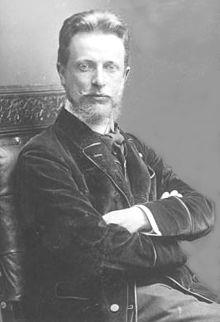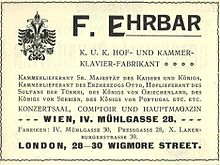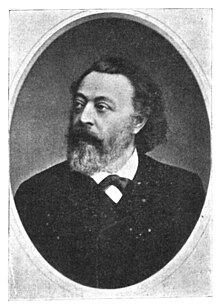Friedrich Ehrbar
Friedrich Ehrbar (born April 26, 1827 in Hildesheim , Germany ; † February 23, 1905 in Gloggnitz , Lower Austria ) was an Austrian piano manufacturer in Vienna .
biography
Friedrich Ehrbar was educated in the orphanage until 1841 and learned and worked from 1841–48 at the piano and organ builder Friederici in Gera . From November 1848 he worked in Vienna in the workshop of the piano maker Eduard Seuffert . After his death in 1855 he married Seuffert's widow Rosa and took over the business in 1857. His instruments received first prizes at the industrial exhibitions in Munich (1854), London (1862) and Paris (1867 and 1878). Ehrbar was the first Austrian manufacturer to use the cast iron full frame for pianos and pianofortes.
In 1876, Friedrich Ehrbar had the Ehrbarsaal built at Mühlgasse 30 in Vienna's 4th district on the site of an old, too small hall in Palais Ehrbar , a Wilhelminian style house with a richly decorated facade. Architect Julius Stepwieser based himself on the architectural style of the Italian High Renaissance. The acoustically ideal performance location in the heart of Wieden quickly became a musical center of the city. Around the turn of the century , the most famous musicians of that time performed there, such as Johannes Brahms , Anton Bruckner , Max Reger , Pietro Mascagni , Ignaz Brüll, and others. Gustav Mahler premiered Das Klagende Lied in the Ehrbarsaal and Arnold Schönberg performed the first part there on January 14, 1910 of his Gurre songs to the public. After the Second World War and an interim re-function as a carpentry shop or hospital, the honor bar, which can accommodate around 500 people and has been restored to its original state, was reopened by a concert by the Vienna Philharmonic under Rudolf Moralt. Today the Ehrbarsaal is mainly used for concerts and events of the Prayner Conservatory , but also often by external organizers.
Due to his entrepreneurial success, Ehrbar became a kuk court and chamber piano manufacturer . He was also the chamber supplier of Archduke Otto, court supplier to the Sultan of Turkey, the King of Greece, the King of Serbia, the King of Portugal, etc. During the construction of the Imperial Court Opera Theater , the manufacturers Streicher, Ludwig Bösendorfer and Ehrbar were invited, two grand pianos to produce which the price of 480 guilders per piece could not exceed. For this achievement Ehrbar and Bösendorfer were awarded the title of chamber supplier in 1869, Streicher already had this title.
The factories were in Mühlgasse 30 in the 4th district, Preßgasse 28 and Laxenburgstraße 39 in the 10th district, from 1910 in a larger and newly built factory building in Laxenburger Straße 139 with two own wood storage areas. In addition to the Comptoir and main store at 28 Mühlgasse in the 4th district, there was also a shop in London at 28–30 Wigmore Street.
In 1898 Friedrich Ehrbar handed over the management of the business to his son Friedrich Benedict Ernst Ehrbar junior.
Seven years later, Friedrich Ehrbar senior died after long suffering on the morning of February 23, 1905 with his family at his country estate in Hart bei Gloggnitz at the age of 78. In accordance with the evangelical rite, he was temporarily buried two days later in the new local cemetery in Gloggnitz until the family crypt was completed.
Friedrich Benedict Ernst Ehrbar junior (born March 4, 1873 in Vienna ; † February 1, 1921 there ) not only directed the fortunes of the Ehrbar piano factory, but was also president of the Vienna Singing Academy from 1900 until his death . In 1898 he too was promoted to k. k. Court and chamber piano manufacturers appointed.
The Ehrbar company continued its production in small numbers until the 1980s.
Ehrbar was one of the first Viennese piano makers to use a controlled attachment length for all strings in the rear attachment. Friedrich Ehrbar instruments are sonically assigned to the best grand pianos from the Vienna School.
The family crypt is located in the Grinzinger Friedhof (group MS, no. 20).
Fonts
- The musical instruments . Vienna 1901.
Awards
- 1862: Golden Cross of Merit with the crown
- 1867: Knight of the Franz Joseph Order
- Honorary citizen of Enzenreith
- Honorary member of the kk military science casino club and numerous musical and humanitarian corporations.
Individual evidence
- ↑ Obituary notice Friedrich Ehrbar sen. In: Neue Freie Presse , February 24, 1905, p. 21 (online at ANNO ).
literature
- Ingrid Haslinger: Customer - Kaiser. The story of the former imperial and royal purveyors . Schroll, Vienna 1996, ISBN 978-3-85202-129-4 .
- Friedrich Ehrbar in the Vienna History Wiki of the City of Vienna
- Austrian music lexicon . Volume 1. Verlag der Österreichischen Akademie der Wissenschaften, Vienna 2002, ISBN 978-3-7001-3043-7 , p. 367.
- Christina Meglitsch: Vienna's forgotten concert halls. The myth of the Bösendorfer, Ehrbar and Streicher halls . Lang, Frankfurt / M. 2005, ISBN 978-3-631-53014-6 .
Web links
- Entry on Friedrich Ehrbar in the Austria Forum (in the AEIOU Austria Lexicon )
- Obituary Friedrich Ehrbar In: Musik- und Theaterzeitung from May 1905, 16th year, No. 3, p. 1. and p. 2
- Side of the conservatory
- Honorable Hall
| personal data | |
|---|---|
| SURNAME | Honorable, Friedrich |
| BRIEF DESCRIPTION | Austrian piano manufacturer owner |
| DATE OF BIRTH | April 26, 1827 |
| PLACE OF BIRTH | Hildesheim |
| DATE OF DEATH | February 23, 1905 |
| Place of death | Gloggnitz , Lower Austria |




